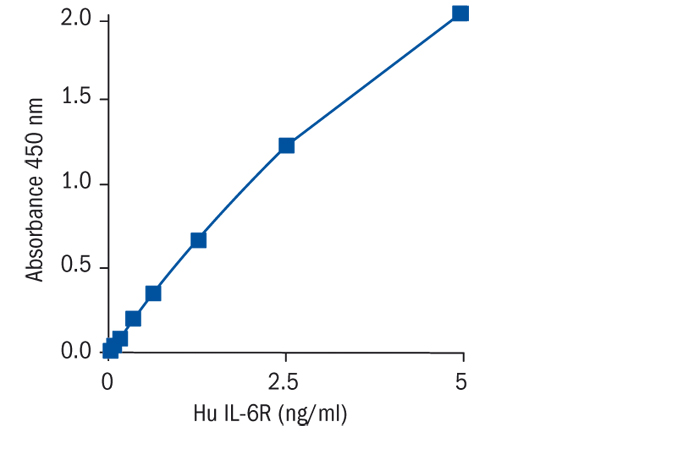Type
Sandwich ELISA, HRP-labelled antibody
Applications
Serum, Plasma-EDTA, Plasma-Heparin, Urine, Amniotic fluid, Cell culture supernatant
Sample Requirements
20 µl (1:50 prediluted)
Shipping
At ambient temperature. Upon receipt, store the product at the temperature recommended below.
Storage/Expiration
Store the complete kit at 2–8°C. Under these conditions, the kit is stable until the expiration date (see label on the box).
Calibration Curve
Calibration Range
0.08–5 ng/ml
Limit of Detection
0.01 ng/ml
Intra-assay (Within-Run)
CV = 1.7%
Inter-assay (Run-to-Run)
CV = 2.2%
Spiking Recovery
101,00%
Dilution Linearity
99,00%
Research topic
Cytokines and chemokines and related molecules, Energy metabolism and body weight regulation, Sepsis, COVID-19
Summary
Interleukin-6 (IL-6) is a multifunctional cytokine involved in the regulation of the immune response, hematopoiesis and acute phase response. It has been recognized to be a member of the a-helical cytokine family.
IL-6 exerts its action via a cell surface receptor which consists of two subunits, an 80 kDa ligand binding subunit (gp80) of 468 amino acids and a 130 kDa signal transducing protein (gp130) of 896 amino acid residues. The cDNAs of both proteins have been cloned. Both subunits belong to the recently recognized hematopoietic receptor superfamily which includes many cytokine receptors. Characterisation of the extracellular portion of the 80 kDa IL-6 receptor revealed the existence of a single immunoglobulin-like domain in the NH2-terminal of the extracellular region, which does not contribute to ligand binding. The remainder of the extracellular domain however is essential for low affinity ligand binding, which consecutively triggers the association of the receptor and gp130 thus forming a high affinity binding site for IL-6. For many cytokine receptors soluble forms have been demonstrated. These soluble molecules have been observed to retain ligand binding capacity and therefore compete with the membrane receptors, thus acting as antagonists. A soluble form of the Human gp80 protein has been detected in serum and urine samples. This 55 kDa protein representing the extracellular portion of gp80 is generated by shedding, a process that seems to be controlled by protein kinase C. It is still functional, indicating that soluble gp80 plays a biological role in promoting IL-6 activity. So far, the soluble IL-6 receptor is unique in acting as an agonist together with its ligand.
The role of soluble IL-6R as a marker for a number of pathological situations has been demonstrated.
Find documents for the lot
Example Instructions for Use (RUO)
Example Instructions for Use (RUO)
Safety Information (RUO)
MSDS (RUO)

